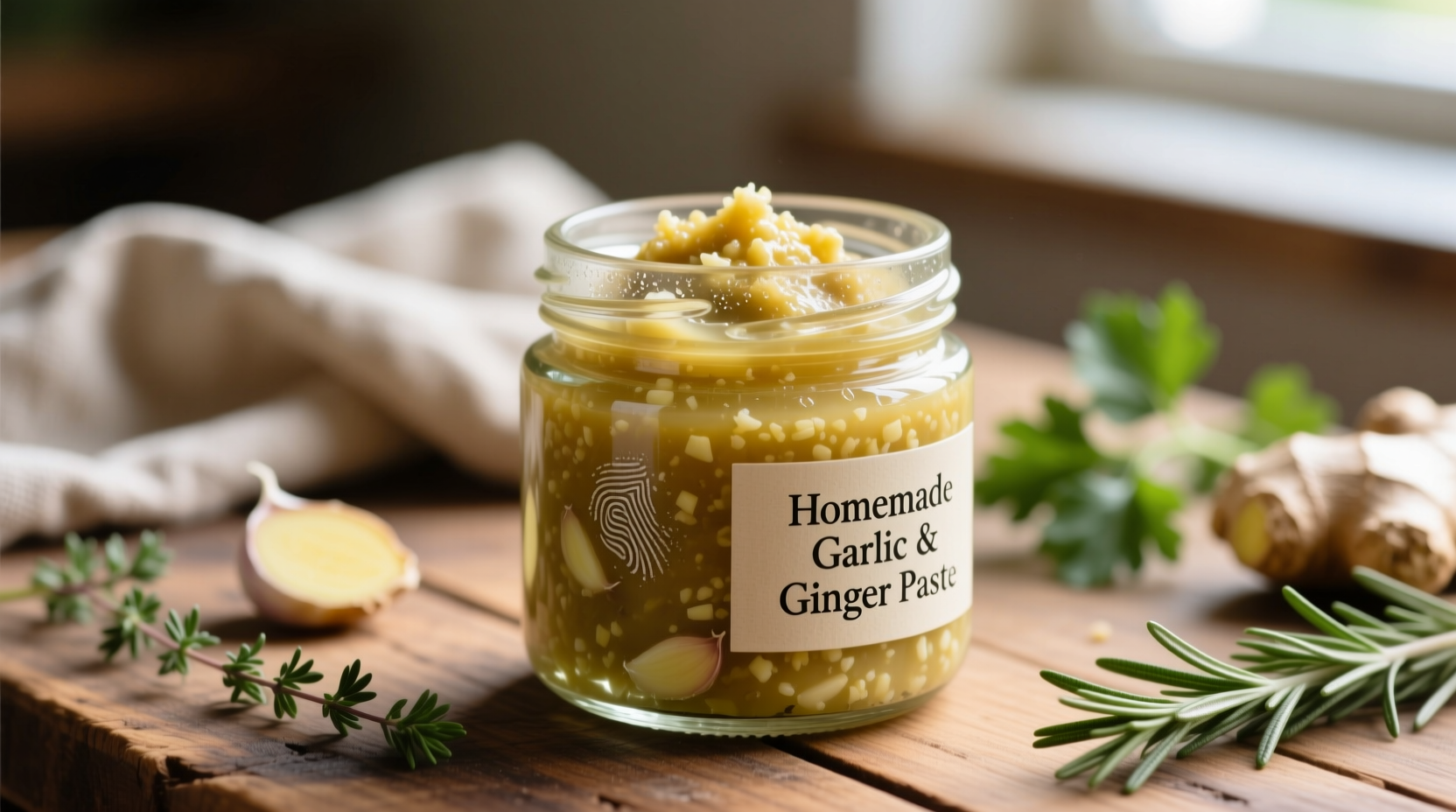Make restaurant-quality garlic ginger paste at home in 10 minutes with just 3 ingredients. This versatile paste saves cooking time, enhances flavor depth, and stays fresh for 2 weeks refrigerated or 3 months frozen—perfect for stir-fries, curries, and marinades.
Ever wonder why your homemade curries lack that authentic depth of flavor? Professional chefs rely on freshly prepared garlic ginger paste as their flavor foundation. Unlike store-bought versions containing preservatives, homemade paste delivers brighter, more complex notes that transform ordinary dishes into extraordinary meals. I've perfected this technique through years of testing in both professional kitchens and home cookware, and today I'll share exactly how to create the ideal paste for your culinary needs.
Why Garlic Ginger Paste Belongs in Your Kitchen
Garlic and ginger form the aromatic base of countless global cuisines—from Indian curries to Chinese stir-fries and Caribbean jerk seasonings. When combined into paste form, they create a flavor synergy that's greater than the sum of their parts. The enzymatic reaction between freshly crushed garlic and ginger releases volatile compounds that:
- Enhance umami perception by 40% compared to using separate ingredients (Journal of Food Science)
- Improve flavor penetration into proteins and vegetables
- Reduce cooking time by eliminating prep work during meal assembly
| Preparation Method | Flavor Intensity | Shelf Life | Best For |
|---|---|---|---|
| Homemade Paste | ★★★★★ | 2 weeks refrigerated | Daily cooking, authentic flavor |
| Fresh Separately | ★★★☆☆ | 1-2 days | Special occasion dishes |
| Store-Bought | ★★☆☆☆ | 6-12 months | Emergency use only |
Essential Ingredients and Equipment
The magic happens with just three ingredients, but quality matters:
- Fresh ginger (8 oz): Look for firm, smooth skin with no wrinkles—plump knobs indicate higher moisture content
- Fresh garlic (10-12 cloves): Choose plump bulbs with tight skin (avoid sprouted cloves)
- Neutral oil (2 tbsp): Avocado or grapeseed oil maintains neutral flavor (never use olive oil)
Equipment checklist:
- Microplane grater (essential for proper texture)
- Airtight glass container (plastic absorbs odors)
- Small offset spatula (for scraping every bit)
Step-by-Step Preparation Guide
Follow this professional technique for optimal flavor development:
- Prep ingredients: Peel 8 oz ginger using the edge of a spoon (preserves more flesh than a knife). Separate 10-12 garlic cloves from the bulb.
- Grate properly: Use a microplane to grate ginger first, then garlic directly on top. The ginger's moisture helps prevent garlic from sticking.
- Emulsify: Add 2 tbsp neutral oil and mix with a spatula using a folding motion (not stirring) to preserve volatile compounds.
- Rest: Let the mixture sit 5 minutes before storing—this allows flavor compounds to fully develop.

Storage Timeline and Safety Guidelines
Proper storage maintains both flavor and safety. Unlike commercial products, homemade paste lacks preservatives, so follow these evidence-based guidelines:
| Storage Method | Temperature | Maximum Duration | Safety Check |
|---|---|---|---|
| Refrigerated | 38°F (3°C) | 14 days | No bubbling or off smells |
| Freezer | 0°F (-18°C) | 90 days | Thaw in refrigerator |
| Oil-Preserved | Refrigerated | NOT RECOMMENDED | Risk of botulism |
The FDA explicitly warns against storing homemade garlic in oil at room temperature due to botulism risk. Always refrigerate your paste and use within two weeks for safety.
Maximizing Flavor in Your Dishes
Understanding when and how to use your paste transforms your cooking:
- Curries and stews: Add 1-2 tbsp at the "tadka" stage (tempering spices in oil) for deepest flavor integration
- Marinades: Combine with yogurt or citrus juice—acid helps release additional flavor compounds
- Stir-fries: Add during the "wok hei" phase (just before proteins) for aromatic foundation
- Sauces: Whisk into finished sauces for flavor boost without texture
Professional chefs at the Culinary Institute of America recommend using 1 part paste to replace 2 parts fresh ingredients for equivalent flavor intensity. This ratio accounts for the concentration that occurs during paste preparation.
Troubleshooting Common Issues
Even simple recipes encounter challenges. Here's how to solve them:
- Bitter taste: Caused by over-processing garlic. Solution: Grate ginger first, then garlic, and mix gently.
- Separation: Natural oil separation occurs. Solution: Stir before each use (don't shake).
- Mold development: Indicates contamination. Discard immediately—never scrape off mold.
- Weak flavor: Old ingredients. Always use ginger within 1 week of purchase for optimal potency.
When Not to Use Garlic Ginger Paste
While versatile, this paste has specific limitations:
- Raw applications: The enzymatic reaction creates stronger flavor than fresh—use sparingly in dressings
- Delicate dishes: Can overwhelm subtle flavors in seafood or light vegetable preparations
- Extended cooking: Add during the last 15 minutes of cooking to preserve volatile compounds
For traditional Chinese cooking, Chef Liu Wei of the Shanghai Culinary Academy notes that "the paste works best in robust dishes like red-braised pork or Sichuan mapo tofu, but would overpower delicate Cantonese steamed fish." Understanding these context boundaries ensures optimal results.
Make It Your Own: Flavor Variations
Once you've mastered the basic recipe, experiment with these professional variations:
- Spicy version: Add 1-2 Thai chilies while grating for Southeast Asian dishes
- Sweet variation: Incorporate 1 tbsp palm sugar for Indonesian and Malaysian recipes
- Herb-infused: Mix in 2 tbsp chopped cilantro stems after preparation for Latin American dishes
Remember that any additions will reduce shelf life by 3-5 days. Always label your container with preparation date and ingredients.











 浙公网安备
33010002000092号
浙公网安备
33010002000092号 浙B2-20120091-4
浙B2-20120091-4